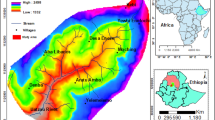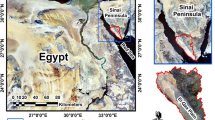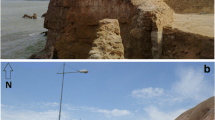Abstract
Domain-specific mesoscale landslide susceptibility mapping (LSM) and risk assessment was carried out along National Highway (NH44) of Jammu and Kashmir, Western Himalaya. The methodology proposed in this study broadly consist three stages including the (1) pre-field component for preliminary thematic map preparation, (2) field component for ground data collection and validation, and (3) post-field component for data updating, processing, and integration. High-resolution Earth Observation (EO) images (Cartosat-DEM-10 m, Cartosat-1 PAN image-2.5 m, Google Earth image-4 m) and other ancillary datasets (SoI topographic, and geological maps) supplemented with extensive field survey were used to generate main causative geo-factor maps for analysis. Slope facet used as a basic unit of mapping preliminarily classified the area into rocky (65.7%) and overburden covered (34.2%) slopes, respectively. An updated inventory of 117 landslide incidence zones comprising 50 debris slides, 34 rockfalls, 20 rock slides, 5 rock topples, 2 debris flows and 6 old slide zones was generated. Depending upon the type and nature of material involved in the slope failure, facets were further classified into debris slide domain, rock slide domain, cut-slope domain and no slide domain for detailed analysis and treatment. The geo-factor maps were weighted using knowledge driven ratings for each factor class as per domain-specific facet using Landslide Susceptibility Estimated Rating (LSER) scheme. The sum up of LSER values for individual causative factors calculated the Total Estimated Susceptibility Values (TESV) that classified the entire area into low, moderate and high susceptibility classes covering an area of 39.8%, 40.0% and 20.1%, respectively. The validation of LSM against high-resolution landslide inventory indicated a higher level of performance of the adopted methodology for the study area. About 80.0% and 10.4% of slope failure incidences coincided perfectly well with high and moderate susceptibility classes. Moreover, the human settlements, agriculture land, roads and bridges, stone crushers and other strategic civil structures (i.e., tunnels, electric line poles and towers, etc.) are the main elements at high risk in the area.


Source: IMD, 2018













Similar content being viewed by others
References
Abdo HG, (2021) Assessment of landslide susceptibility zonation using frequency ratio and statistical index: a case study of Al-Fawar basin, Tartous, Syria. Int J Environ Sci Technol pp 1–20
Alexander D (1992) On the causes of landslides: Human activities, perceptions and natural processes. Environ Geol Water Sci 20(3):165–179
Anbalagan R (1992) Landslide hazard evaluation and zonation mapping in mountainous terrain. Eng Geol 32:69–277
Ayalew L, Yamagishi H (2005) The application of GIS-based logistic regression for landslide susceptibility mapping in the Kakuda-Yahiko Mountains, Central Japan. Geomorphology 65:15–31
Balsubramani K, Kumaraswamy K (2013) Application of geospatial technology and information value technique in landslide hazard zonation mapping: a case study of Giri Valley. Himachal Pradesh Disaster Adv 6:38–47
Bappaditya K, Nath A, Bhattacharya S, Saraswati S, Chandra BR (2020) GIS based Landslide Hazard Zonation Mapping by Weighted Overlay Method on the Road Corridor of North Sikkim Himalayas. India Res. Square.
Batar AK, Watanabe T (2021) Landslide susceptibility mapping and assessment using geospatial platforms and weights of evidence (woe) method in the Indian Himalayan region: recent developments, gaps, and future directions. ISPRS Int J Geo-Inf 10:114
Bathrellos GD, Gaki-Papanastassiou K, Skilodimou HD, Papanastassiou D, Chousianitis KG (2012) Potential suitability for urban planning and industry development by using natural hazard maps and geological—geomorphological parameters. Environ Earth Sci 66(2):537–548
Bathrellos GD, Skilodimou HD, Chousianitis K, Youssef AM, Pradhan B (2017) Suitability estimation for urban development using multi-hazard assessment map. Sci Total Environ 575:119–134
BIS (2017) Preparation of landslide hazard zonation maps in mountainous terrains-guidelines, Part 1 Meso scale, IS 14496 (Part‐1), December 2017, New Delhi. Bureau of Indian Standards, Government of India
Chen W, Sun Z, Han J (2019) Landslide susceptibility modeling using integrated ensemble weights of evidence with logistic regression and random forest models. Appl Sci 9:171
Chen W, Lei X, Chakrabortty R, Pal SC, Sahana M, Janizadeh S (2021) Evaluation of different boosting ensemble machine learning models and novel deep learning and boosting framework for head-cut gully erosion susceptibility. J Environ Manage 15(284):112015
Cruden DM, Varnes DJ (1996) Landslide types and processes, special report. Transp. Res. Board. Natl Acad Sci 247:36–75
Dai FC, Lee CF, Zhang XH (2001) GIS-based geo-environmental evaluation for urban land use planning: a case study. Eng Geol 61:257–271
Dikshit A, Satyam N, Pradhan B, Kushal S (2020) Estimating rainfall threshold and temporal probability for landslide occurrences in Darjeeling Himalayas. Geosciences 24:225–233
Du J, Glade T, Woldai T, Chai B, Zeng B (2020) Landslide susceptibility assessment based on an incomplete landslide inventory in the Jilong Valley, Tibet. Chinese Himalayas Eng Geol 270:105572
El-Magd A, Ali SA, Pham QB (2021) Spatial modeling and susceptibility zonation of landslides using random forest, naïve bayes and K-nearest neighbor in a complicated terrain. Earth Sci Inf 14(3):1227–1243
Es-Smairi A, El Moutchou B, El Ouazani TA, Namous M, Mir RA (2022) Landslide susceptibility mapping using GIS-based bivariate models in the Rif chain (northernmost Morocco). Geocarto Int 37(27):15347–15377
Froude MJ, Petley DN (2018) Global fatal landslide occurrence from 2004 to 2016. Natural Hazards Earth Syst Sci 18(8):2161–2181
Ghoshal TB, Bodas MS, Ghosh S (2013) A multi-thematic and deterministic-cum heuristic methodology for Meso scale (1:5,000/10,000) landslide susceptibility zonation. Indian J Geosci 67(3):217–228
Girma F, Raghuvanshi TK, Ayenew T, Hailemariam T (2015) Landslide hazard zonation in Ada Berga District, Central Ethiopia—a GIS based statistical approach. J Geomat 90:25–38
GSI (2012) Pub. GSI. No. 30, part X, Miscellaneous Publication 30
GSI (2020) Standard Operating Procedure (SOP) for meso scale (1:10,000/ 5000) land slide susceptibility mapping, (2021), Published by: Geological survey of India, Mission-IV, Central Headquarter, Kolkata, India
Hansen A (1984) Landslide hazard analysis. In: Brunsden D, Prior DB (eds) Slope instability. John Wiley, New York, pp 523–602
Joshi V, Naithani A, Negi GC (2001) Study of Landslides in Mandakini River Valley, Garhwal-Himalaya. India GAIA 1(16):87–95
Kamran K, Valizadeh, Shahabi H, Piroti A (2010) Natural disasters evaluation of landslide hazard by using fuzzy logic. The 2nd International Geography Symposium, Kemer-Antalya-Turkey
Kanungo DP, Arora MK, Sarkar S, Gupta RP (2006) A comparative study of conventional, ANN black box, fuzzy and combined neural and fuzzy weighting procedures for landslide susceptibility zonation in Darjeeling Himalayas. Eng Geol 85(3–4):347–366
Karpouza M, Chousianitis K, Bathrellos GD, Skilodimou HD, Kaviris G, Antonarakou A (2021) Hazard zonation mapping of earthquake-induced secondary effects using spatial multi-criteria analysis. Nat Hazards 109:637–669
Karsli FE, Atasoy M, Yalcin A, Reis S, Demir OĞ, Gokceoglu C (2009) Effects of land-use changes on landslides in a landslide-prone area (Ardesen, Rize, NE Turkey). Environ Monit Assess 156:241–255
Kritikos T, Robinson TR, Davies TR (2015) Regional coseismic landslide hazard assessment without historical landslide inventories: a new approach. J Geophys Res: Earth Surface 120:711–729
Lan HX, Zhou CH, Wang LJ, Zhang HY, Li RH (2004) Landslide hazard spatial analysis and prediction using GIS in the Xiaojiang watershed. Yunnan China Eng Geol 76(1):2
Lombardo L, Cama M, Conoscenti C, Märker M, Rotigliano EJ (2015) Binary logistic regression versus stochastic gradient boosted decision trees in assessing landslide susceptibility for multiple-occurring landslide events: application to the 2009 storm event in Messina (Sicily, southern Italy). Nat Hazards 79:1621–1648
Mengistu F, Suryabhagavan KV, Raghuvanshi TK, Lewi E (2019) Landslide Hazard zonation and slope instability assessment using optical and InSAR data: a case study from Gidole town and its surrounding areas, southern Ethiopia. Remote Sen Land 3(1):1–4
Mir RA, Jain SK, Lohani AK, Saraf AK (2018) Glacier recession and glacial lake outburst flood studies in Zanskar basin, western Himalaya. J Hydrology 1(564):376–396
Mir RA, Habib Z, Kumar A (2022) Predicting landslide susceptibility zones and its controlling factors along NH44 of Union Territory: Jammu & Kashmir, a northwest Himalayan region. (EGCON-2022) International Conference on “Engineering Geology and Geotechniques for safe and sustainable infrastructure” Theme: Geohazards and Disaster Risk Reduction held from 16–17 November, 2022. By ISEG and GSI, Govt of India, at Kolkata
Mir RA, Thappa DR, Kumar A (2023) Assessing hotspot and vulnerable zones of disaster along Ammarnath Yatra route in Sind catchment, Kashmir Himalaya: A Geospatial and Field Appraisal, 5th International Conference on "Disaster, Risk and Vulnerability (DRVC 2023)" from 19–21 January, 2023 held at the School of Environmental Sciences, Mahatma Gandhi University, Kottayam, Kerala
Negi HS, Kumar A, Rao NN, Thakur NK, Shekhar MS, Snehmani, (2020) Susceptibility assessment of rainfall induced debris flow zones in Ladakh-Nubra region. Indian Himalaya J Earth Syst Sci 129:30
Parise M (2001) Landslide mapping techniques and their use in the assessment of the landslide hazard. Phys Chem Earth Part C 26:697–703
Raghuvanshi TK, Ibrahim J, Ayalew D (2014) Slope stability susceptibility evaluation parameter (SSEP) rating scheme–an approach for landslide hazard zonation. J Afr Earth Sci 99:595–612
Raju KCC (1961) Geological report on the preliminary investigation of landslides along the Jammu-Srinagar National Highway, J&K State.
Ramli MF, Yusof N, Yusoff MK, Juahir H (2010) Lineament mapping and its application in landslide hazard assessment: a review. Bull Eng Geol Environ 69:215–233
Rozos D, Bathrellos GD, Skillodimou HD (2011) Comparison of the implementation of rock engineering system and analytic hierarchy process methods, upon landslide susceptibility mapping, using GIS: a case study from the Eastern Achaia County of Peloponnesus. Greece Environ Earth Sci 63:49–63
Sengupta A, Gupta S, Anbarasu K (2010) Rainfall thresholds for the initiation of landslide at Lanta Khola in north Sikkim, India. Nat Hazards 52:31–42
Sharma SK, Akram V (2020) Macro-scale (1:50,000) landslide susceptibility mapping in parts of toposheet nos. 43O/6, 43O/10 & 43O/14 covering parts of Anantnag, Doda, Kishtwar, districts, Jammu and Kashmir (J&K) FSP 2019 -20, Unpublished report Geological Survey of India
Sharma LP, Patel N, Ghose MK, Debnath P (2012) Influence of Shannon’s entropy on landslide-causing parameters for vulnerability study and zonation—a case study in Sikkim. India Arab J Geosci 5:421–431
Skidmore M (2001) Risk, natural disasters, and household saving in life cycle model. Japan World Econ 13:15–34
Tiku AK (1965) A note on the experimental blasting conducted near the Khuni Nala on the Jammu-Srinagar National Highway, Jammu and Kashmir State (January, 1966)- F.S. 1964–65, GSI report
Varnes DJ (1978) Slope movement types and processes. In: Schuster RL, Krizek RJ (eds) Special report 176: Landslides: analysis and control. Transportation and Road Research Board, National Academy of Science, Washington D. C, pp 11–33
Verma RS (1967) Geological report on the landslides along the Jammu Srinagar national highway (1a). Unpublished report Geological Survey of India, Jammu
Wieczorek GF (1984) Preparing a detailed landslide-inventory map for hazard evaluation and reduction. Bull Associat Eng Geologists 21:337–342
Xie P, Wen H, Ma C, Baise LG, Zhang J (2018) Application and comparison of logistic regression model and neural network model in earthquake-induced landslides susceptibility mapping at mountainous region. China Geomat Nat Haz Risk 9(1):501–523
Yi Y, Zhang Z, Zhang W, Xu Q, Deng C, Li Q (2019) GIS-based earthquake-triggered-landslide susceptibility mapping with an integrated weighted index model in Jiuzhaigou region of Sichuan Province, China. Nat Hazards Earth Syst Sci 19:1973–1988
Yilmaz I (2009) Landslide susceptibility mapping using frequency ratio, logistic regression, artificial neural networks and their comparison: a case study from Kat landslides (Tokat-Turkey). Comput Geosci 35:1125–1138
Zhu J, Baise LG, Thompson EM (2017) An updated geospatial liquefaction model for global application. Bull Seismol Soc Am 107(3):1365–1385
Acknowledgements
The authors are grateful to the Geological Survey of India, Jammu and Kashmir, for providing opportunity to work in this area during its Field Season Program FSP: 2019-20. The authors are also grateful to IRS ISRO for providing Cartosat data sets, and USGS for providing satellite data freely. The authors are grateful to all the local people who assisted during the field work.
Funding
The work was supported by Geological Survey of India, Ministry of Mines, Government of India.
Author information
Authors and Affiliations
Contributions
RAM conceived the idea, conducted elaborate data analysis for writing, drafting and revising the manuscript. ZH assisted in field work and field data collection. AK supervised in the field data collection. NAB assisted in editing of the manuscript.
Corresponding author
Ethics declarations
Conflict of interest
The authors declare that the research was conducted without any commercial or financial relationships construed as a potential conflict of interest.
Additional information
Publisher's Note
Springer Nature remains neutral with regard to jurisdictional claims in published maps and institutional affiliations.
Rights and permissions
Springer Nature or its licensor (e.g. a society or other partner) holds exclusive rights to this article under a publishing agreement with the author(s) or other rightsholder(s); author self-archiving of the accepted manuscript version of this article is solely governed by the terms of such publishing agreement and applicable law.
About this article
Cite this article
Mir, R.A., Habib, Z., Kumar, A. et al. Landslide susceptibility mapping and risk assessment using total estimated susceptibility values along NH44 in Jammu and Kashmir, Western Himalaya. Nat Hazards 120, 4257–4296 (2024). https://doi.org/10.1007/s11069-023-06363-6
Received:
Accepted:
Published:
Issue Date:
DOI: https://doi.org/10.1007/s11069-023-06363-6




